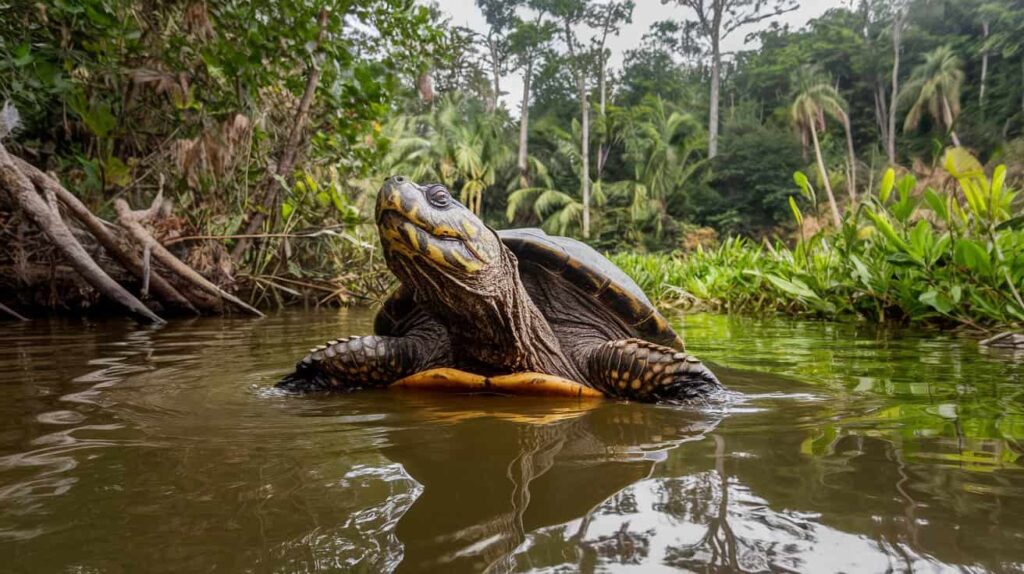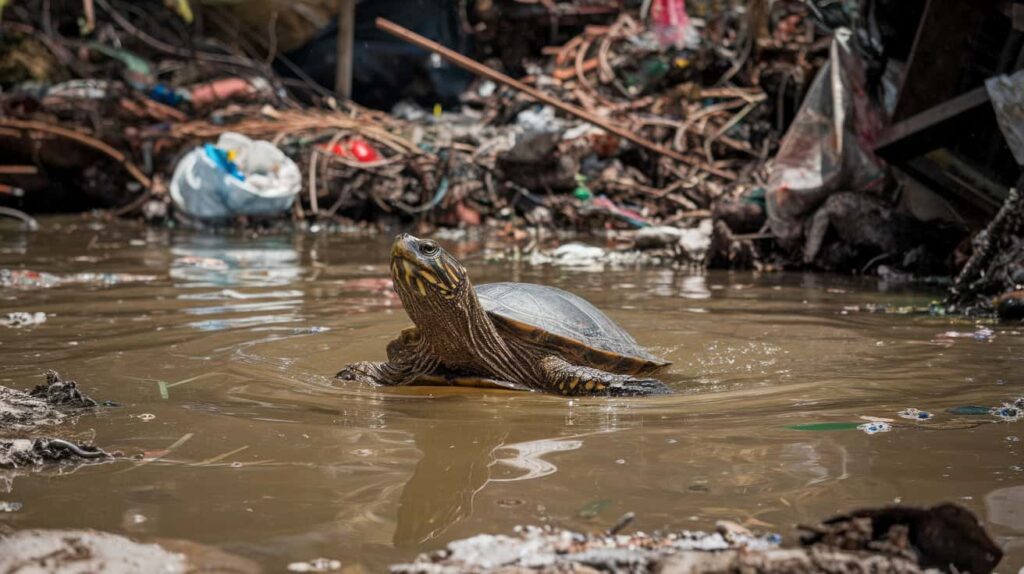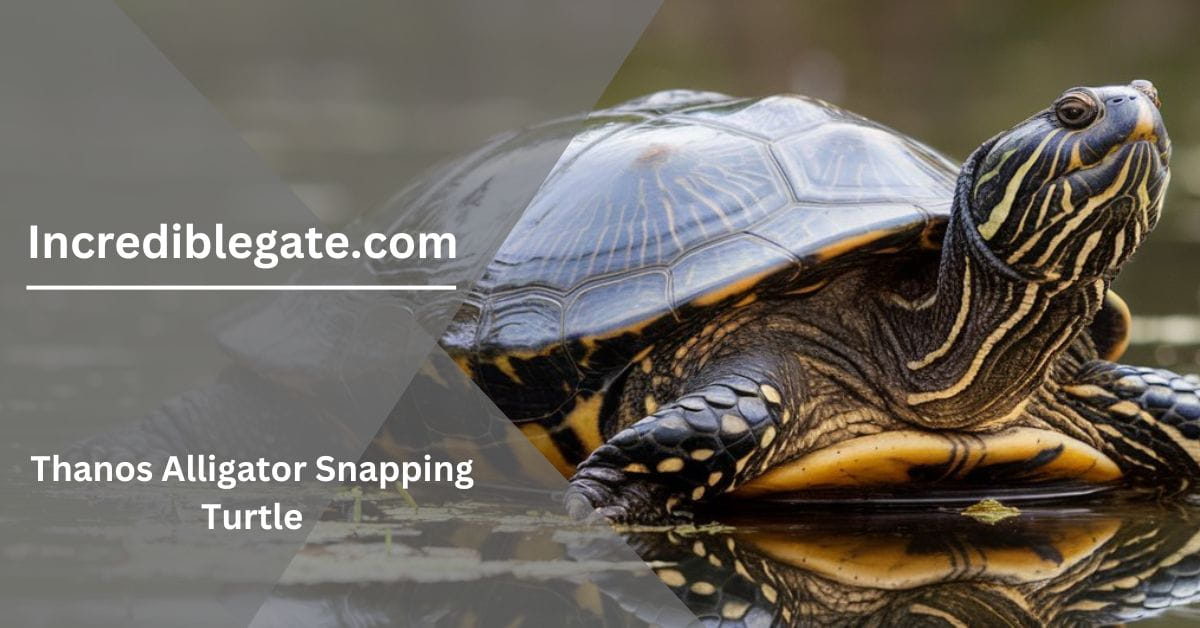The Thanos Alligator Snapping Turtle is a massive, ancient reptile native to the southeastern United States. Known for its strength, durability, and striking appearance, this turtle has gained popularity not only for its biological importance but also for the awe it inspires.
Named after the infamous comic book villain Thanos, the turtle’s powerful jaws, large body, and rugged, prehistoric look have captured the interest of nature lovers and scientists alike. In this article, we’ll take a closer look at this amazing species, covering everything from its behaviour and habitat to the challenges it’s up against today.
What Is The Thanos Alligator Snapping Turtle?
The Thanos Alligator Snapping Turtle is one of the largest freshwater turtles in North America, known for its dinosaur-like appearance and immense strength. This ancient species has existed for millions of years, and its evolutionary traits have made it a successful apex predator in its environment.
Physical Characteristics:
- Size: These turtles can weigh up to 200 pounds, with some individuals reaching 250 pounds.
- Jaws: Equipped with extremely powerful jaws that can snap bones and even cut through metal objects.
- Shell: Rough and rugged, resembling the ancient armour of dinosaurs.
- Eyes: Small but highly functional, allowing for sharp vision even in murky water.
Why Is It Called The Thanos Alligator Snapping Turtle?
The Thanos Alligator Snapping Turtle is named after the Marvel comic book villain Thanos because of its impressive size and strength. Just like the character, this turtle is notable for its powerful jaws and large, rugged appearance. The name highlights its formidable presence and dominance in its environment.
The turtle’s striking features and impressive size make it stand out, drawing a parallel to the larger-than-life persona of the comic book villain. This powerful reptile truly lives up to its namesake, capturing the imagination of all who encounter it.
Where Can The Thanos Alligator Snapping Turtle Be Found?
The Thanos Alligator Snapping Turtle can be found in the southeastern United States. It lives in slow-moving rivers, lakes, swamps, and canals where the water is calm and murky. These habitats provide the turtle with ample food and places to hide. The warm, wet environment of these areas is ideal for its survival.

This turtle prefers areas with plenty of vegetation and submerged logs, which offer both food and protection. By staying in these environments, the Thanos Alligator Snapping Turtle can thrive and carry out its important ecological role.
Habitat And Distribution Of The Thanos Alligator Snapping Turtle:
Geographic Range:
The Thanos Alligator Snapping Turtle is commonly found across the southeastern United States. Key regions where they are most often spotted include:
- The Mississippi River and its connecting waterways.
- Gulf Coast states ranging from Texas to Florida.
- Certain parts of the Midwest, such as Indiana and Illinois.
Preferred Ecosystems:
These turtles thrive in a variety of freshwater environments, including:
- Slow-moving rivers
- Swamps and bayous
- Oxbow lakes
- Large ponds
Reasons for Thriving in These Areas:
The slow-moving waters of these habitats provide an ideal environment for the Thanos Alligator Snapping Turtle. The abundance of prey, submerged vegetation, and fallen logs offer both food and shelter. Additionally, the soft, muddy bottoms allow the turtles to burrow, offering protection and warmth, especially during colder seasons.
Behaviour And Hunting Techniques Of The Thanos Alligator Snapping Turtle – Let’s See!
The Thanos Alligator Snapping Turtle is a skilled predator with unique hunting strategies. As a mostly solitary and nocturnal creature, it spends much of its time submerged, waiting for prey. Known for its ambush hunting style, it remains still for long periods, using minimal energy while waiting for prey to come close.
Hunting Techniques
- Camouflage and Ambush: The turtle blends into its surroundings, often lying on the muddy bottoms of rivers or lakes. It uses its rough, algae-covered shell as camouflage.
- Worm-Like Tongue Lure: One of its most distinctive hunting methods is its tongue, which has a worm-like appendage. The turtle keeps its mouth open and wiggles this lure to attract fish, believing it’s an easy meal. Once the fish gets close, the turtle snaps its powerful jaws shut with lightning speed.
- Powerful Jaws: The Thanos Alligator Snapping Turtle’s jaws are exceptionally strong, enabling it to crush bones and shells with ease, making it a formidable predator.
This efficient hunting technique allows the turtle to conserve energy while securing a wide range of prey, from fish and frogs to snakes and even smaller turtles.
What Does The Thanos Alligator Snapping Turtle Eat?
The Thanos Alligator Snapping Turtle is a carnivorous predator with a varied diet. It primarily feeds on fish, frogs, snakes, and crustaceans like crayfish, but will also eat smaller turtles, birds, and small mammals when available. Additionally, it scavenges on dead animals found in its environment.
Using its ambush hunting technique, the turtle stays still for long periods, luring prey with its worm-like tongue before snapping its powerful jaws shut to capture its meal. This diverse diet helps it thrive in its freshwater habitat, ensuring it can adapt to changes in prey availability. Its slow metabolism also allows it to survive longer periods without food when necessary.
The Role Of The Thanos Alligator Snapping Turtle In The Ecosystem:
- Apex Predator: Regulates populations of prey species such as fish, frogs, and smaller reptiles, preventing overpopulation and maintaining ecological balance.
- Nutrient Recycling: Consumes dead animals, aiding in the decomposition process and recycling nutrients back into the ecosystem.
- Sediment Aeration: Burrows in soft, muddy bottoms, helping to aerate the sediment and improve water quality for other aquatic organisms.
- Habitat Health: By controlling prey populations and contributing to nutrient cycles, the turtle supports the overall health and stability of its freshwater habitat.
- Biodiversity Support: Its presence and activities help sustain a diverse range of species, ensuring a balanced and functional ecosystem.
Scientific Classification And Related Species – Must Read!
The Thanos Alligator Snapping Turtle belongs to the scientific classification of Chelydra serpentina, a species known for its large size and powerful bite. This turtle is part of the Chelydridae family, which includes other snapping turtles.
Scientific Classification:
| Category | Classification |
| Kingdom | Animalia |
| Phylum | Chordata |
| Class | Reptilia |
| Order | Testudines |
| Family | Chelydridae |
| Genus | Chelydra |
| Species | C. serpentina |
Related Species:
- Common Snapping Turtle (Chelydra serpentina): Found throughout North America, it is similar in appearance but generally smaller.
- Alligator Snapping Turtle (Macrochelys temminckii): Native to the southeastern U.S., this species is closely related but typically larger and has a more pronounced shell structure.
- Smooth Softshell Turtle (Apalone mutica): While not a snapping turtle, it shares the same habitat range and can be found in similar waterways.
Life Cycle And Reproduction Of The Thanos Alligator Snapping Turtle – Don’t Miss Out!
- Mating Season: Thanos Alligator Snapping Turtles mate in water during spring and early summer. Males and females come together for this crucial part of their life cycle.
- Nesting: After mating, females leave the water to find a suitable spot on land, typically near the water’s edge, where they lay their eggs in sandy or muddy soil.
- Egg Incubation: The female deposits around 20-40 eggs and covers them with soil to protect them from predators. The eggs incubate for about 100 to 140 days before hatching.
- Hatching Process: Hatchlings emerge from the eggs and must quickly make their way to the water to avoid predators and ensure their survival.
- Juvenile Development: Young turtles are more active and grow rapidly. Their shells gradually harden over time, providing increased protection as they mature.
- Adulthood: As they reach adulthood, these turtles become more sedentary and rely on their ambush hunting techniques. They continue to grow throughout their lives.
- Longevity: Thanos Alligator Snapping Turtles can live up to 70 years. Their long lifespan and slow growth rate allow them to reproduce multiple times.
What Are The Main Threats To The Thanos Alligator Snapping Turtle?
The Thanos Alligator Snapping Turtle faces several significant threats that impact its survival. Habitat destruction due to urban development, agriculture, and wetland drainage has severely reduced their natural living spaces. Pollution in water bodies, including chemicals and plastic waste, risks their health and food sources. Illegal hunting and overharvesting for the pet trade and traditional medicine further threaten their numbers.

Additionally, climate change affects their nesting sites and temperature-dependent sex determination, potentially disrupting their reproductive success. Invasive species can also compete for food and alter the balance of their ecosystem. Conservation efforts are crucial to address these threats and ensure the survival of this remarkable turtle.
How Can People Help Protect The Thanos Alligator Snapping Turtle?
Support Conservation Efforts:
Contribute to organizations and programs dedicated to the conservation of the Thanos Alligator Snapping Turtle and its habitat. Donations and volunteer work can help fund research, protection initiatives, and habitat restoration projects. Your support can directly impact the survival of this magnificent species.
Preserve Natural Habitats:
Advocate for and participate in habitat preservation projects. Support efforts to protect wetlands, rivers, and other crucial environments that the turtles rely on. By maintaining these ecosystems, you help ensure that the turtles have the resources they need to thrive.
Reduce Pollution:
Minimize pollution by properly disposing of waste and reducing the use of harmful chemicals. Participate in local clean-up events to help keep water bodies free from debris and pollutants. Reducing pollution improves water quality and overall habitat health for the Thanos Alligator Snapping Turtle.
Follow Regulations:
Adhere to local laws and regulations regarding wildlife protection. Avoid hunting or disturbing these turtles and report any illegal activities to the authorities. Compliance with wildlife protection laws helps safeguard the turtles and their habitats from harm.
Educate Others:
Raise awareness about the Thanos Alligator Snapping Turtle and its conservation needs. Educate friends, family, and community members about the importance of protecting this species and its habitat. Increased awareness can lead to greater community support for conservation efforts.
Unique Features That Make the Thanos Alligator Snapping Turtle Stand Out:
The Thanos Alligator Snapping Turtle boasts several distinctive traits that set it apart:
- Worm-like Tongue for Hunting: This turtle has a specialized, worm-like tongue it uses to lure fish within striking distance. This unique hunting adaptation allows it to effectively ambush prey.
- Ability to Stay Submerged for Up to 50 Minutes: It can remain underwater for up to 50 minutes, which aids in both hunting and evading predators. This adaptation is crucial for its aquatic lifestyle.
- Heavy, Rugged Shell Resembling Ancient Armor: Its shell is large and covered with rugged, overlapping plates, providing excellent protection and contributing to its dinosaur-like appearance. This armour-like shell offers both defence and camouflage.
- Sharp Beak Capable of Biting Through Almost Anything: Equipped with a powerful, sharp beak, the Thanos Alligator Snapping Turtle can bite through tough materials, including bones and shells. This strong beak enhances its ability to capture and consume a variety of prey.
FAQs:
How does the Thanos Alligator Snapping Turtle hunt?
The Thanos Alligator Snapping Turtle uses a unique ambush hunting strategy. It remains motionless with its worm-like tongue extended to attract prey. When prey approaches, the turtle snaps its jaws shut with incredible force to capture its meal.
What are the preferred habitats of the Thanos Alligator Snapping Turtle?
The Thanos Alligator Snapping Turtle prefers slow-moving rivers, swamps, bayous, oxbow lakes, and large ponds. These environments offer abundant prey and cover for protection. They thrive in areas with submerged vegetation and soft, muddy bottoms.
How does climate change affect the Thanos Alligator Snapping Turtle?
Climate change impacts the Thanos Alligator Snapping Turtle by affecting their nesting sites and temperature-dependent sex determination. Temperature changes can disrupt reproductive success and habitat conditions. These environmental shifts pose a significant threat to their survival.
Are Thanos Alligator Snapping Turtles endangered?
Yes, the Thanos Alligator Snapping Turtle is considered vulnerable due to threats such as habitat destruction and illegal hunting. Conservation status can vary, but their population is declining in some areas. Efforts are needed to improve their conservation status and protect their habitats.
How long does it take for a Thanos Alligator Snapping Turtle to reach maturity?
A Thanos Alligator Snapping Turtle typically takes 10 to 15 years to reach sexual maturity. Growth is slow, and they continue to grow throughout their lives. This prolonged maturation period is typical for large, long-lived species.
Conclusion:
The Thanos Alligator Snapping Turtle is a remarkable and ancient species with a vital role in its ecosystem. Its impressive size and unique traits make it a fascinating creature worth protecting. Unfortunately, it faces significant threats from habitat loss and pollution.
By supporting conservation efforts and raising awareness, we can help ensure that this extraordinary turtle continues to thrive for generations to come.

